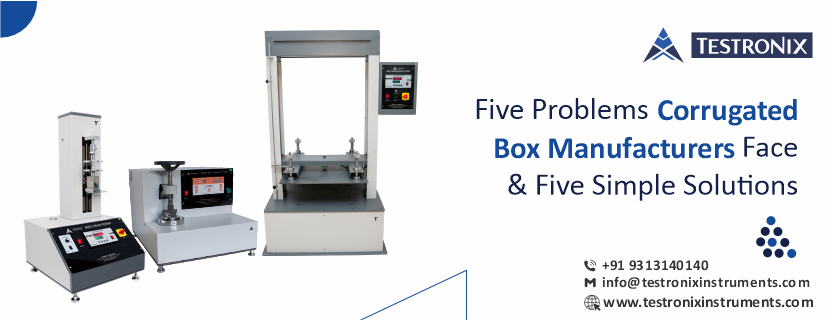Reviewed by Anurag Mishra (Sr. Technical Consultant)

Are you into manufacturing corrugated boxes? If yes, then you would definitely know how important it is for your packaging boxes to be durable and reliable enough to keep the contents safe. Isn’t it true that a sturdy box can make all the difference?
However, there are common problems that corrugated box manufacturers face when it comes to quality control. Let’s quickly look at these problems and then, explore some simple solutions to help you overcome them.
Let's take a closer look at the five most common problems that you, as a corrugated box manufacturer, might be facing. And parallelly, explore simple solutions to each problem.
1. Insufficient Strength: One of the main issues is – strength of the box - boxes not being able to withstand heavy loads or rough handling during transportation. This can result in damaged products and unhappy customers. The solution? Investing in a box compression tester, which measures how much weight a box can handle before collapsing.
2. Inadequate Protection: Boxes need to provide proper protection for their contents, especially fragile items. A thickness gauge can help manufacturers determine if the packaging material meets industry standards and ensure optimal protection.
3. Poor Print Quality: Corrugated boxes often serve as marketing tools with logos, product information, and branding printed on them. However, poor print quality can diminish brand value and professionalism. Regularly testing printing techniques using paper and board testing instruments, such as scuff resistance tester, helps maintain high-quality prints.
4. Inconsistent Dimensions: When boxes have inconsistent dimensions, it becomes challenging to stack them efficiently during storage or shipping processes. Implementing an edge crush tester allows manufacturers to measure the stacking strength of their boxes accurately.
5. Cost Control Issues: Manufacturers are constantly looking for ways to reduce costs without compromising quality control standards.
√ One of the main reasons why a box compression tester is so important is that it helps identify potential weaknesses in packaging materials. By subjecting boxes to controlled pressure, manufacturers can determine their load-bearing capacity and evaluate if they meet industry standards. This information allows them to make necessary adjustments and improvements, reducing the risk of product damage during transportation or storage.
√ Moreover, using a box compression tester can help manufacturers optimize their packaging design. By testing different prototypes under varying conditions, they can understand how factors like board grade, thickness, and construction affect performance. Armed with this knowledge, companies can make informed decisions about material selection and create more robust packaging solutions for their products.
√ In addition to improving product quality and reducing costs associated with damaged goods or customer complaints, investing in a box compression tester also demonstrates a commitment to quality control. It shows that manufacturers are proactive in ensuring their packaging meets stringent industry requirements and reinforces trust among customers.
When it comes to choosing a box compression tester, there are several factors that you need to consider.
1. Firstly, you need to assess your specific quality testing needs and material requirements. Answer the following questions for yourself - What kind of boxes do you manufacture? What is the average weight they need to withstand? Understanding your unique situation will help you find a tester that meets your exact specifications.
2. Another important consideration is the testing capacity of the machine. You want a box compression tester that can handle the maximum load that your boxes will be subjected to during transportation and storage. Make sure to check the weight range and test speed capabilities of different models before making a decision.
3. Accuracy is also crucial when selecting a box compression tester. You want reliable results that accurately reflect the strength and durability of your boxes. Look for machines with advanced sensor technology and precise measurement capabilities.
4. Ease of use is another factor worth considering. Choose a box compression tester that is user-friendly and intuitive, so that operators can easily perform tests without extensive training or technical expertise.
5. Don't forget about maintenance and support services. Find out if there are authorized service centers in your area for routine maintenance or repairs if needed.
By taking all these factors into account, you can choose the right box compression tester for your business needs, ensuring quality control throughout your production process
The edge crush tester is a highly beneficial instrument used by corrugated box manufacturers to measure the compressive strength of their products.
1. By simulating real-world conditions, this testing equipment allows manufacturers to evaluate how well their boxes can withstand pressure from different angles.
2. With an edge crush tester, manufacturers can identify any weak spots in their corrugated boxes and make necessary improvements before they reach customers' hands. This helps reduce the risk of product damage during transit and ensures customer satisfaction.
3. Choosing the right edge crush tester for your manufacturing process requires careful consideration. Factors such as:
√ maximum load capacity,
√ test speed, accuracy, and
√ ease of use should be taken into account while making a decision.
Investing in an efficient edge crush tester not only improves quality control but also saves costs associated with product returns or damages due to insufficient box strength. With this essential tool in place, corrugated box manufacturers can confidently deliver reliable packaging solutions that meet industry standards and customer expectations.
Thickness gauges also play an integral role in maintaining high-quality standards. These instruments enable precise measurements of key parameters such as edge crush value (ECV) and thickness of paperboard materials used for manufacturing corrugated boxes.
With comprehensive testing using these instruments, manufacturers can gain valuable insights into various aspects of their packaging materials. They can assess factors like strength, durability, resilience to external forces, moisture resistance capability, and overall structural integrity.
It has now become evident how quality control measures are critical for businesses operating within this industry niche.
By adopting advanced technologies and investing in reliable testing instruments, manufacturers can ensure that their corrugated boxes